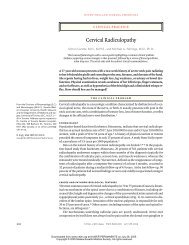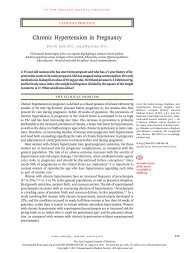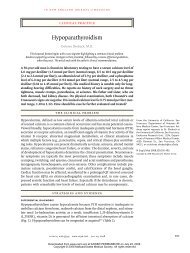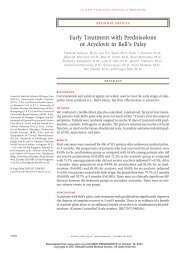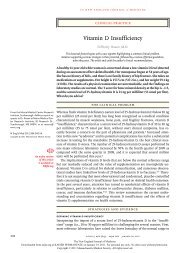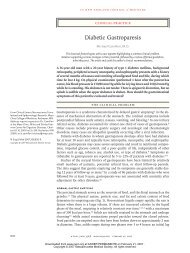Care of Transsexual Persons - Q-Notes for Adult Medicine
Care of Transsexual Persons - Q-Notes for Adult Medicine
Care of Transsexual Persons - Q-Notes for Adult Medicine
You also want an ePaper? Increase the reach of your titles
YUMPU automatically turns print PDFs into web optimized ePapers that Google loves.
T h e n e w e ngl a nd j o u r na l o f m e dic i n e<br />
Table 1. Diagnostic Criteria <strong>for</strong> Gender Identity Disorder.*<br />
Strong and persistent cross-sex identification (not merely a desire <strong>for</strong> any perceived cultural advantages <strong>of</strong> being the<br />
other sex)<br />
Children (at least four criteria must be met)<br />
Repeatedly stated desire to be a member <strong>of</strong> the other sex or insistence on actually being a member <strong>of</strong> the other sex<br />
In boys, preference <strong>for</strong> cross-dressing or simulating female attire; in girls, insistence on wearing only stereotypically<br />
masculine clothing<br />
Strong and persistent preferences <strong>for</strong> cross-sex roles in make-believe play or persistent fantasies <strong>of</strong> being a<br />
member <strong>of</strong> the other sex<br />
Intense desire to participate in the stereotypical games and pastimes <strong>of</strong> the other sex<br />
Strong preference <strong>for</strong> playmates <strong>of</strong> the other sex<br />
Adolescents and adults (at least one criterion must be met)<br />
Stated desire to be <strong>of</strong> the other sex<br />
Frequent attempts to pass as the other sex<br />
Desire to live or be treated as the other sex lives or is treated<br />
Conviction <strong>of</strong> having the typical feelings and reactions <strong>of</strong> the other sex<br />
Discom<strong>for</strong>t with original sex or sense <strong>of</strong> inappropriateness in the role <strong>of</strong> that sex<br />
Children (at least one criterion must be met)<br />
In boys, assertion that penis or testes are disgusting or will disappear, assertion that it would be better not to<br />
have a penis, or aversion to rough-and-tumble play and rejection <strong>of</strong> male stereotypical toys, games, and activities;<br />
in girls, rejection <strong>of</strong> urinating in a sitting position, assertion that she has or will have a penis, assertion<br />
that she does not want to have breasts or menstruate, or marked aversion to normative feminine clothing<br />
Adolescents and adults (at least one criterion must be met)<br />
Preoccupation with getting rid <strong>of</strong> primary and secondary sex characteristics (e.g., request <strong>for</strong> hormones, surgery,<br />
or other procedures to physically alter sexual characteristics and simulate the other sex) or belief in<br />
having been born with the wrong sex<br />
No concurrent physical intersex condition<br />
Clinically significant distress or impairment in social, occupational, or other important areas <strong>of</strong> functioning<br />
* These criteria were adapted from the Diagnostic and Statistical Manual <strong>of</strong> Mental Disorders (DSM) (fourth edition, text<br />
revision). 4<br />
sexual adults, a male:female ratio (according to<br />
original sex) <strong>of</strong> 3:1 is common throughout the<br />
Western world 12 but not elsewhere (e.g., Japan<br />
and Serbia). 14,15 A male preponderance is also<br />
noted be<strong>for</strong>e puberty, but gender identity disorder<br />
in children <strong>of</strong>ten resolves, and in adolescents the<br />
ratio is closer to 1:1. 16,17 The subsequent increase<br />
in the male:female ratio is explained by the<br />
higher frequency <strong>of</strong> men with late-onset gender<br />
identity disorder. 12 <strong>Transsexual</strong>ism after early<br />
puberty is generally an unalterable condition. 5,16<br />
S tr ategies a nd E v idence<br />
General Principles <strong>of</strong> Treatment<br />
Pr<strong>of</strong>essional acceptance <strong>of</strong> transsexualism and<br />
its hormonal and surgical treatment has grown.<br />
Interventions are indicated only after comprehensive<br />
psychological assessment has confirmed<br />
not only that the DSM diagnostic criteria have<br />
been fulfilled but also that the patient meets the<br />
criteria <strong>for</strong> readiness to make the transition to<br />
the other sex (as detailed below). 11<br />
<strong>Persons</strong> with gender identity disorder may<br />
have unrealistic expectations about what being a<br />
member <strong>of</strong> the opposite sex entails. 1,11 Hormonal<br />
treatment should there<strong>for</strong>e be preceded<br />
and accompanied by an extended period (at least<br />
1 year) during which the patient lives full time<br />
as a person <strong>of</strong> the desired sex. This real-life experience<br />
is essential <strong>for</strong> providing insight into<br />
the new sex status, allowing the patient to become<br />
accustomed to the social interactions arising<br />
from it. 1,11 Such sex reassignment, by enabling<br />
the patient to experience life as a person<br />
<strong>of</strong> the subjectively appropriate sex, reduces gen-<br />
1252<br />
n engl j med 364;13 nejm.org march 31, 2011<br />
The New England Journal <strong>of</strong> <strong>Medicine</strong><br />
Downloaded from nejm.org at KAISER PERMANENTE on March 30, 2011. For personal use only. No other uses without permission.<br />
Copyright © 2011 Massachusetts Medical Society. All rights reserved.






